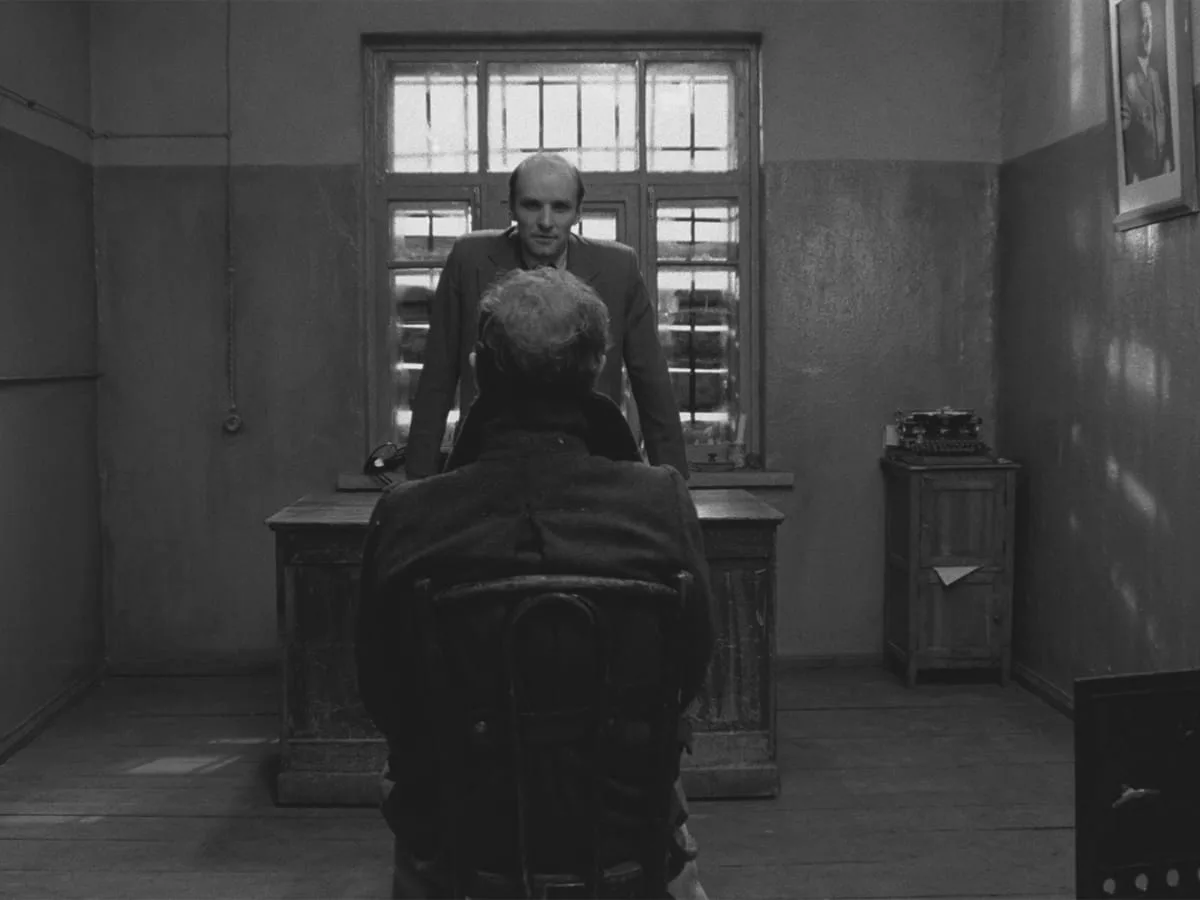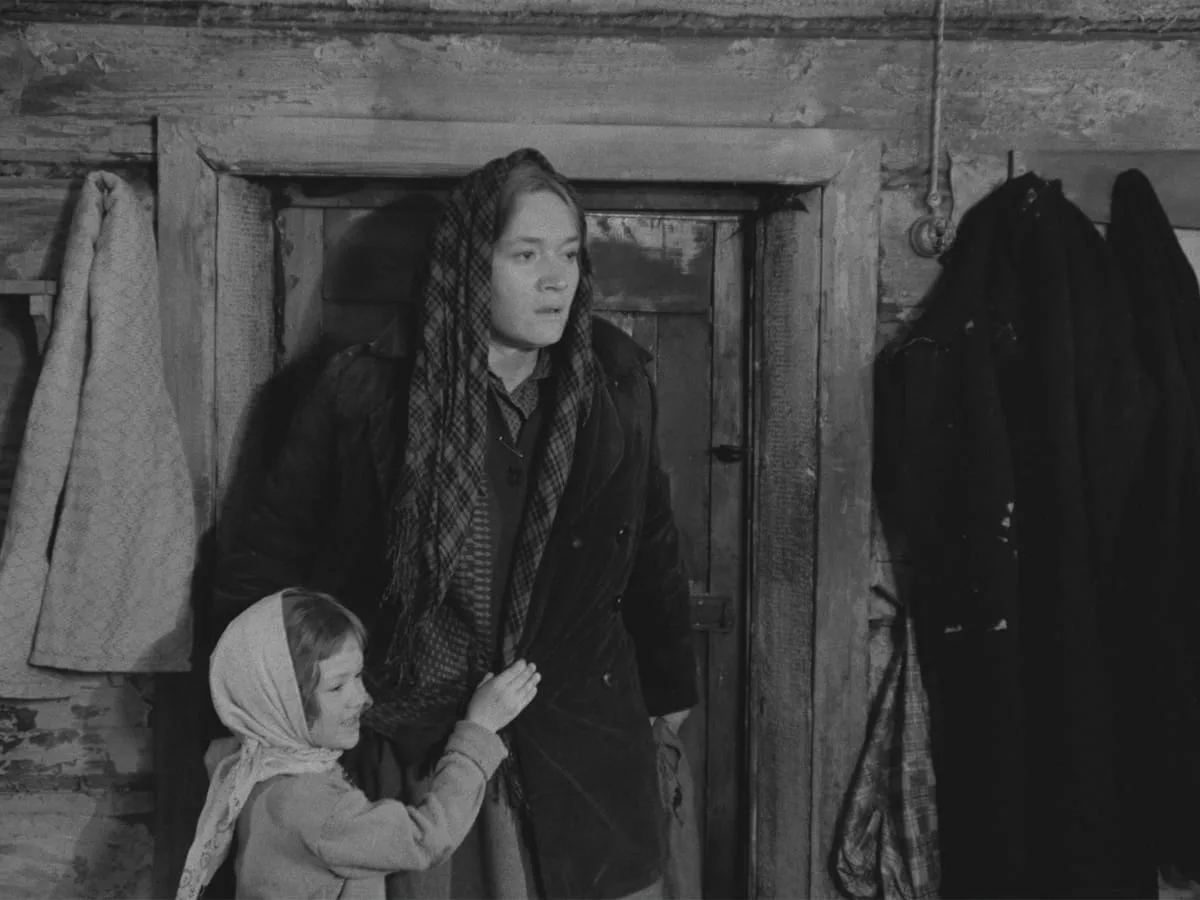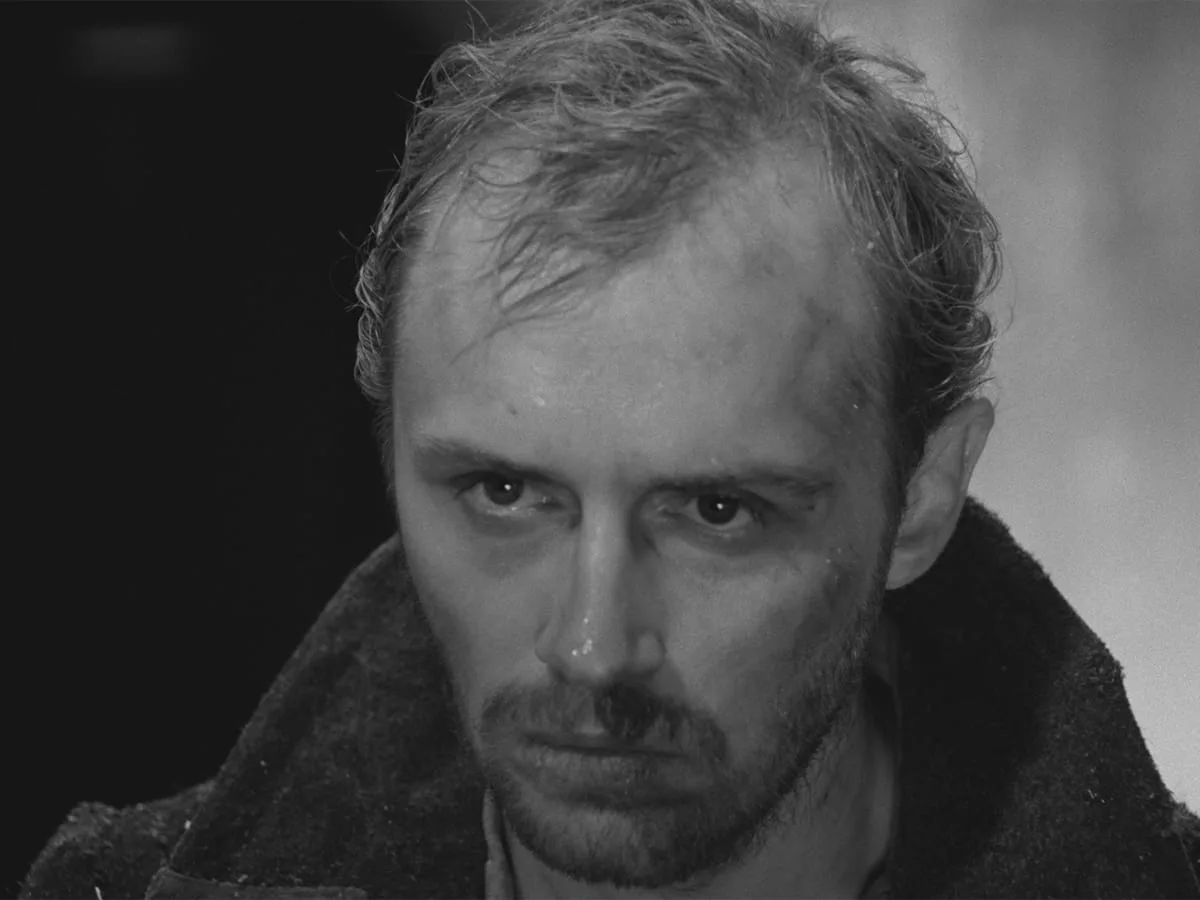Movies
Transcending Hell on Earth in Larisa Sheptiko’s “The Ascent” | Far Flungers

Sotnikov stands on the cusp of death. He is among a small group of individuals awaiting death by hanging. We notice an old man among the condemned. His gaze is fixed inward, as though already retreating into the quiet depths of memory. Next to him, a woman breathes in uneven gasps. Her cheeks are stained with the traces of tears that have almost dried in the cold. A helpless child frantically tries to look for an escape; she finds none. Within that line-up of doomed souls, Sotnikov stands apart. While expressions of fear and sorrow make up most of their faces, Sotnikov appears utterly calm. There is a quiet dignity radiating from his demeaner. His eyes are fixed, not on the men who will kill him, but on something beyond, something unseen, something sacred.
For a film with so many memorable scenes, Larisa Sheptiko’s “The Ascent” (1977) feels shamefully neglected. While Soviet war films like Mikhail Kalatozov’s “The Cranes Are Flying” (1957), Andrei Tarkovsky’s “Ivan’s Childhood” (1962), and Elem Klimov’s “Come and See” (1985) are constantly hailed as some of the most harrowing anti-war films ever made, “The Ascent” gets overlooked. Part of the reason can be attributed to Larisa Sheptiko’s unfortunate short-lived career. The irrefutably talented filmmaker was killed in a car accident outside Leningrad on June 2, 1979. At the time of her death, Sheptiko was married to director Elem Limov, who later made “Come and See,” a film that was clearly influenced by her work. Today, Elem Limov is relatively well-known amongst film enthusiasts. Sometimes I wonder, if Sheptiko had lived, would she have benefited from the resurgence of interest in Soviet filmmakers? Afterall, her films were unofficially suppressed by authorities while she was alive. Regardless, “The Ascent” deserves to be revisited. The way it subverts many tropes and conventions of the Soviet war film to transcend the traditional anti-war statement is simply remarkable.
Watching this film, I kept asking myself, is it is even possible to truly create an anti-war film? I realized that by looking at the film through a contemporary lens, the paradox of the Soviet anti-war film gets exposed. What differentiates “The Ascent” from other Soviet films is that it aims for something much more profound than patriotism. Its complex existential message transcends nationalism to investigate the human condition. Sheptiko’s film is less interested in presenting a simplistic anti-war message and aims for something higher, spiritual transcendence.
Films about war have existed as long as people have had the capacity to point a camera at subject matter, and even though cinematic depictions of warfare have been around for a very long time, the complexity of the genre is still the subject of debate amongst filmmakers, critics, and academics. The complications that arise when trying to define and examine an anti-war film has been the stuff of debate for years now. François Truffaut once famously said, “it is impossible to make an anti-war narrative film, because any film will inevitably sanitize and glamorize war”. Likewise, World War II veteran and filmmaker, Samuel Fuller, once proclaimed that for a film to be “truly true to the actual nature of war, bullets would need to be spraying out from the screen, taking out members of the audience at random, one by one, in scattershot carnage”. On the other hand, Steven Spielberg once told Newsweek that “every war movie, good or bad, is an anti-war movie”.
The truth is, generalizing and declaring all films to be either pro or anti-war seems to oversimplify the complexity of the argument. I truly believe that each film needs to be examined on its own merit. While it is true that war films will never mirror the actual horrors of war, they can take a clear stance against a specific war or the idea of war in general. The question is, do depictions of the brutality of war alone validate the declaration of a film to be anti-war, or can this brutality indirectly justify the need to go to war? In order to answer this question, one needs to take a deeper look at the history of Soviet narrative war films, and how “The Ascent” fits within that collective.
During the early days of silent cinema, Russia used propaganda films as a tool to spread the communist agenda. Films like Sergei Eisenstein’s “The Battleship Potemkin” (1925) deviated from historical facts to serve the purposes of propaganda and art. Roger Ebert reiterated this in his review of Eisenstein’s film when he wrote how the film opted to portray masses of men moving in synchronized unity. He wrote, “’The Battleship Potemkin’ is conceived as class-conscious revolutionary propaganda, and Eisenstein deliberately avoids creating any three-dimensional individuals. Instead, masses of men move in unison.” During World War II, Soviet film production, encompassing both fiction and newsreels, was entirely dedicated to supporting the war effort. If one were to categorize these films, they would clearly fall under pro-war films. That said, in comparison, the post-Stalinist era of cinema was quite the opposite.
During Leonis Brezhnev’s rule, the Soviet film shifted its focus. Films highlighted the cost of war on families and individuals. Instead of creating stylized epics in the Socialist Realist tradition, a bold few filmmakers initiated a subtle revolution in both the style and content of war films. The main preoccupation of Soviet war films became human loss as opposed to focusing on the USSR’s contributions to the victory over the Nazis. This is where Sheptiko’s anti-war film comes in. Larisa Sheptiko’s quest for truth created a powerful legacy of anti-war films. The Ukrainian-born filmmaker was extremely political. Her films were grounded in humanism rather than ideology. In the opening battle scene of “The Ascent,” Sheptiko clearly establishes this humane approach.
We see partisans retreating from the enemy in the harsh landscape of Belarus. We notice Rybak (Vladimir Gostyukhin) and Sotnikov (Boris Plotnikov) firing at the enemy as their group desperately attempt to flee the carnage. As they rest, Sheptiko cuts to closeups of the victims of war. We see a woman holding on to a man gasping for air, two children extending their hands for food, an old woman looks out at the distance, her eyes piercing empty space. By focusing on these haunting portraits, Sheptiko brings innocent lives caught in conflict to the foreground of her story. Sheptiko examines not only individual suffering but also how it affects others. In fact, when Rybak and Sotnikov are not searching for food on their own, they’re always surrounded by women, children, and the elderly.
One of the war genre conventions that frequently appear in films that aim to condemn war is when they feature children as victims to atrocities. This is highlighted in several sequences throughout the film. After Rybak gets caught taking shelter in the home of Demschikha (Lyudmila Polyakova), the mother gets separated from her children, and eventually gets executed publicly. In another sequence, we get introduced to the teenage daughter of a Jewish shoemaker who insinuates that Nazis tortured her to give up names. This depiction of abuse of women as an inevitable result of war and the horrific fate that befalls them is a clear indication that Sheptiko was arguing against war. Perhaps the film’s most anti-war stance can be observed in how it challenges the myth of the war hero, a hero who get glorified by showcasing his extreme bravery in the battlefield. This is not the case for the hero depicted in “The Ascent”. In fact, the film’s most horrifying battlefield is a small claustrophobic room where two men are locked into a battle of wills.
As Sotnikov gets interrogated by Portnov (Anatoli Solonitsyn), Portnov leans forward and says, “You’ll have to trouble your conscience; one way or the other, you’ll have to.” But Sotnikov refuses to give up the whereabouts of his comrades, declaring: “There are things more important than one’s own hide.” This makes Portnov break into a sinister laugh. “Where? What is it? What’s it made of? That’s nonsense. We’re mortal. With death, everything ends for us- all of life. The entire world.” In moments like these, Sheptiko’s film elevates itself to a higher realm of consciousness. It isn’t afraid to ask existential questions that trouble the collective thoughts of humanity. Is there more to reality than our physical experience of it? Or does one’s consciousness evaporate into eternal oblivion upon death? In the heat of the moment, Portnov assures Sotnikov that his death will be meaningless. “For what? As an example for future generations? But you won’t have a heroic death either. You won’t just die. You’ll croak like a traitor, and if you won’t tell, someone else will, and we’ll write it off to you.” In other words, his sacrificial heroism won’t be celebrated; it won’t even be forgotten. No matter how heroic he acts, Sotnikov will be written off as a traitor.

This bleak turn of events, along with the portrayal of death as devoid of redemption and meaning, are hallmarks of the anti-war genre. However, the final moments of “The Ascent” are crucial to understanding why the film transcends any stance for or against the war. In one last desperate attempt to save the innocent lives around him, one last attempt at patriotism, Sotnikov shouts, “They’re all here by accident! Shoot me alone!” before declaring his loyalty to the motherland. When it doesn’t work out, Rybak bails on him and betrays his country in exchange for his life. The story of two partisans becomes an allegory of Christ and Judas. “The Ascent” is filled with religious imagery. As the remainder of the prisoners make their way up the slope to the gallows, the walk can be interpreted as symbolic for their ascent into the heavens. Sheptiko even frames Sotnikov in a way that is strongly reminiscent of Russian iconography. Sotnikov always appears surrounded by warm burning candles in the torture chambers, which contrasts well with the cold serene landscapes of the exteriors, a clear representation of heaven and hell on earth.
When they put the rope around his neck, Sotnikov locks eyes with a child in the crowd. A tear slides down the child’s cheek, and we see the slightest smirk on Sotnikov’s face. The child represents “the future generations” that Portnov referred to during their interrogation. Sotnikov’s stubborn loyalty to the motherland may have been pointless, still resulting in the death of everyone around him, but in the end, he will rest peacefully knowing that the future generations witnessed the atrocities committed on that day. Meanwhile Rybak is seen with a guilty conscious, a tortured soul tormented by what he’s done for the rest his days. In one shot we see Rybak surrounded by dogs. The shot clearly alludes to a previous quote in the film. “I’ll die like a human being now, not like a dog.” Of course, whenever a film depicts the atrocities of Nazi Germany, there is an argument to be made that it could be perceived as a justification for this specific war, which in itself defeats the purpose of the anti-war film.
Looking at “The Ascent” through the lens of spectatorship, there is no telling how people will receive the film’s message. Like all narratives that rely on showing rather than telling, narrative film creates space for multiple interpretations. Films set during the Great Patriotic War of 1941 to 1945, particularly those produced during the war, established a set of conventions that largely remained consistent in the portrayal of war, both before and after Vladimir Putin’s rise to power. These conventions encompass the demonization of the enemy, the portrayal of war as a righteous cause in defense of Holy Russia, and the representation of the ordinary Russian soldier as an emblem of the honesty and integrity of the Russian soul. Looking at “The Ascent” today, knowing that Russia continually uses narratives of anti-fascism as a justification to wage war within countries like Syria and Ukraine, would this dismiss the film’s content as indirect propaganda?
If denouncing fascism was the film’s sole agenda, perhaps it might, but “The Ascent” thrives for something much more intellectually engaging than an anti-war rhetoric against fascism. This is precisely why it stands out from the post-Stalinist anti-war film catalog. It engages viewers, both intellectually and emotionally, by looking at the very essence of morality. In one pivotal scene, perhaps the most important line in the film is uttered by Sotnikov. He says, “Now I understand. I understand. The important thing is to be true to yourself.” This line encapsulates the notion that to act ethically one must be self-governed as opposed to serve any higher ideals. Once he comes to this realization of moral conscience, even death itself couldn’t disrupt his peace of mind. “The Ascent” transcends its post-Stalinist anti-war content by operating between the realms of black and white, right and wrong, heaven and hell, good and evil, life and death to present an anti-war film about the conscience that guides our actions.
“The Ascent” is now streaming on The Criterion Channel.
-
Entertainment4 weeks ago
Here’s what DeepSeek AI does better than OpenAI’s ChatGPT
-
News4 weeks ago
DeepSeek AI gets hit with data privacy red flag by Italy and Ireland
-
Entertainment4 weeks ago
DeepSeek says its newest AI model, Janus-Pro, can outperform OpenAI’s DALL-E
-
Entertainment4 weeks ago
DeepSeek AI: What you need to know about the ChatGPT rival
-
Entertainment4 weeks ago
DeepSeek R1: Why AI experts think it’s so special
-
Entertainment4 weeks ago
iOS 18.3 is here. 3 major changes to know
-
Sports2 weeks ago
Brighton vs. Chelsea 2025 livestream Watch FA Cup for free
-
Entertainment4 weeks ago
OpenAI’s Operator saves deleted data months longer than ChatGPT


























